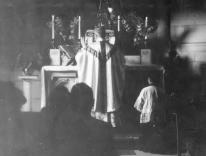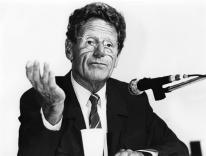[Editors’ note: In the October 26, 1979 Commonweal, the editors commented on John Paul’s first visit to the United States.)
No one within reach of a television or a newspaper could have passed the first week in October unaware of the extraordinary personal magnetism of John Paul II and of the intense and enthusiastic response produced by his visit to the United States. The visit was a cascade of dramatic moments-solemn, effervescent (“Rack ‘em up, stack ‘em up, break ‘em in two! Holy Father, we’re for you!”) challenging, reflective (the intricately constructed address at the UN), humorous and symbolic (a Southern Baptist president and the Roman pontiff emerging together from the White House). So emotional was the welcome given the pope that not surprisingly, some observers were troubled. Was this an expression of genuine religious feeling-or the adulation of a superstar among superstars? Did it signify deep attachment to Christian belief-or the spiritual emptiness that provokes quick intoxication with any number of psychological and religious “uppers”? The answer, of course, is all of the above. The pope’s visit was many things, and indeed its real meaning may only be established by the answer to the question he left us: how will this charisma be translated into leadership?
In asking that question, we do not want to draw a sharp line between what the pope did-or is-and what he said. One of the most important things about this pontiff is the extent to which the message is the man. That is the way it ought to be for a religious leader, and that such is the pope’s opinion as well is revealed not only in his deliberate actions but in the way he preaches, above all, not church nor a set of doctrines but Christ. The vitality and spontaneity of John Paul II seem to be as essential a statement about the life of love he urges as any of the specific norms of behavior, whether sexual or economic, he insists upon—and this point the crowd grasped intuitively. But the man has departed, and his message will now be communicated through institutions and persons of a much less electrifying sort. That is why his chosen words are so important.
The pope’s pronouncements fell into two categories, his moral, social and political statements directed toward the world at large and his moral and disciplinary statements directed toward the church. Concerning the first, William F. Buckley, Jr., rushed to tape a TV show expressing his distress that the pope-in urging Americans not merely to share the crumbs from their table with the nation’s and the world’s poor-was treading in economic matters where he had neither expertise nor authority. Others, in contrast, asked whether the pope’s words were not merely truisms. If they were truisms, however, so is much of the Gospel. At a time when the possibility of slower economic growth may move people to hold hard to what they possess and avert their gaze from those in need, the pope’s admonitions seen particularly appropriate. It is true that our society has always preferred practicing materialism to preaching it, but the new era of tough-mindedness may reverse even that. Here is a writer in the current issue of Harper’s: “The present rebellion against materialism and bigness, however understandable its origins, shrivels the human spirit. People begin by searching for an inner peace, and end by staring vacantly at sunsets....” To that view, the pope’s “truisms” are direct contradictions. In some ways, to be sure, John Paul II has been less specific, even though no less emphatic, in his appeals for peace and social justice than were John XXIII and Paul VI. But a document like the UN address, with its careful explication of the interrelationship between spiritual and material rights, is totally beyond the exhortatory. If, as several good reporters concluded, the diplomats at the UN were somewhat perfunctory in their reception of the pope’s message, that is not because he said too little but because their diplomatic antennae told them that the papal argument offered no easy comfort for anyone, East or West.
The second category of papal statements, those directed essentially to Catholics, leave us deeply troubled. The pope dealt with a range of issues, often in a swift and assertive manner. Each of them deserves consideration in its own right. The release of priests from their vows, for example, is not the same issue as the future of the celibate priesthood in the Roman rite. Abortion, homosexuality and contraception are separate questions—and the pope has probably contributed to the dif¬ficulties already existing in the public debate by appearing to treat them as a piece. Whether the ordination of women poses a question of human rights depends entirely on the grounds for disallowing such ordination. Unless the church presents better reasons against such ordination than have so far been adduced, it is hard to see why human rights are not pertinent any less than if the priesthood were denied to members of certain races or if the church revived its traditional teachings on slavery.
It is not the specific positions taken by the pope on these issues and others-some of which this journal supports, some of which we have long dissented from-but his vision of the teaching church that gives us the most concern. Repeatedly John Paul, invoked the image of the “deposit of truth” to be safeguarded and effectively communicated as though it were a static, reified reality, a treasure protected and at most given a different display case for every age, rather than a living and growing tradition rooted in history and experience. The valid¬ity of The Christian testimony of masses of believers and of disparate local churches seemed to be affirmed only when it matched the view from the top; certainly the pope did not suggest the importance of the reverse process. The insistence of the pope on human rights in his addresses on the secular order found little echo in these statements: only a dismissal of them in connection with women’s ordination and a declaration of “the right of the faithful not to be troubled by theories and hypotheses that they are not expert in judging or that are easily simplified or manipulated by public opinion for ends that are alien to the truth.”
What are the institutional implications of this vision of the teaching church? In an age of fads and media oversimplifica¬tion, it is not hard to divine some truth in a phrase about “the right...not to be troubled”; but if such a phrase has a ring that seems more fitting to the Polish Communist party than a dissenting Polish religious leader, it is because the institutional behavior based on such phrases more commonly resembles that of authoritarian societies than communities of free mature believers. The characteristic note of the pope’s personal appearances was a loving openness to human cares and experience. If his words are taken as approval of closed and authoritarian church institutions, then the link between charisma and leadership will have been lost. A pilgrimage that was magnificently inclusive will reinforce what, in the Church is militantly exclusive.
There are ready explanations for the pope’s attitude. He received poor advice. He wants to take things firmly in hand now so as to be able to exercise greater flexibility later. But the likelier possibility is that he is clearly articulating his particular, heroic vision of the church. That Christ must be central, that love is demanding, that faithfulness requires sacrifice, that drift should be resisted-this should be readily endorsed, however hard to live by. But insofar as his vision minimizes the continuing struggle not only to communicate old truth effectively but, in the light of experience, really discover what the old truths mean; insofar as it encourages a teaching church that is not equally a learning one, the huge promise of his papacy may go unfulfilled.
Please email comments to [email protected] and join the conversation on our Facebook page.
Share
Previous Story
The Election of John Paul II
Next Story
LETTERS


